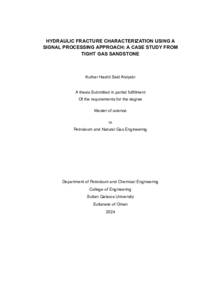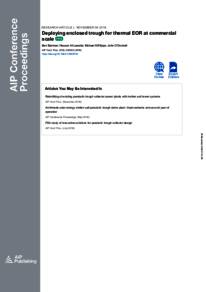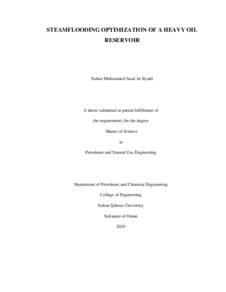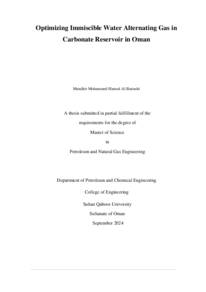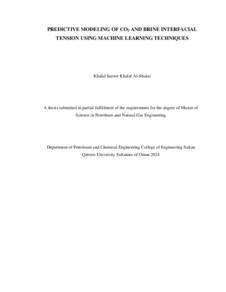Document
Hydraulic fracture characterization using a signal processing approach : a case study from tight gas sandstone.
Source
Master's thesis
Other titles
محاكاة التفاعلات بين ثاني اكسيد الكربون والصخور و السوائل الصخرية في توصيف المكامن
Country
Oman
City
Muscat
Publisher
Sultan Qaboos University
Gregorian
2024
Language
English
Thesis Type
Master's thesis
English abstract
The oil and gas industry faces significant challenges when extracting natural gas from
deep, tight formations, particularly ultra-low-permeability shale and sandstone
reservoirs. Economic production requires hydraulic fracturing, and a robust
geomechanical model is essential for optimizing hydraulic fracture design.
Traditionally, closure pressure determination involves the Diagnostic Fracture
Injection Test (DFIT) and G-function analyses, which require predefined values for
instantaneous shut-in pressure (ISIP) and introduce uncertainties. This thesis addresses
the critical challenge of estimating closure pressure in deep tight gas reservoirs,
specifically those within the depth range of 4000 to 5000 meters, located in North
Oman. Methodology initially involves conducting three DFIT tests and performing Gfunction analysis, followed by wavelet analysis. By decomposing the pressure signal
into different levels, we analyze the noise of the signal over time. Level 6 is identified
as suitable for analysis, with the energy distribution of the pressure signal showing
decreasing levels of noise energy, eventually dropping to a minimum level at closure.
Closure pressure is then determined based on this zero-strength point. Comparative
analysis with the G-function method aligns well for three datasets, and further testing
across four additional DFITs cases from different fields yields corroborative results,
showcasing the effectiveness and reliability of the proposed wavelet-based approach.
The main advantage of our approach lies in its lack of pre-assumptions about fracture
geometry or well type, relying solely on recorded pressure signals during the falloff
period. This unique feature extends its applicability across various formations, rocks,
and well types, making it a versatile tool for optimizing fracture design and enhancing
hydrocarbon recovery.
Arabic abstract
تواجه صناعة النفط والغاز تحديات كبيرة عند استخراج الغاز الطبيعي من التكوينات العميقة والضيقة، وخاصة الصخر الزيتي وخزانات الحجر الرملي ذات النفاذية المنخفضة للغاية. يتطلب الانتاج الاقتصادي التكسير الهيدروليكي، ويعتبر النموذج الجيوميكانيكي القوي ضروريًا لتحسين تصميم الكسر الهيدروليكي. تقليديًا، يتضمن تحديد ضغط الاغلاق اختبار حقن الكسر التشخيصي (DFIT (وتحليالت وظيفةG ، والتي تتطلب قي ًما محددة مسبقً (ISIP (وتؤدي إلى عدم اليقين. الضغط الاغلاق اللحظي تتناول هذه الورقة التحدي الحاسم المتمثل في تقدير ضغط الاغالق في مكامن الغاز الضيقة العميقة، وتحديدا تلك التي تقع في نطاق عمق يتراوح بين 4000 إلى 5000 متر، وتقع في شمال عمان. تتضمن منهجيتنا في البداية إجراء ثالثة اختبارات DFIT وإجراء تحليلfunction-G ، يليه تحليل المويجات. ومن خلال تحليل إشارة الضغط إلى مستويات مختلفة، نقوم بتحليل ضوضاء الاشارة مع مرور الوقت. تم تحديد المستوى 6 على أنه مناسب للتحليل، حيث يُظهر توزيع الطاقة إلشارة الضغط انخفاض مستويات طاقة الضوضاء، وينخفض في النهاية إلى الحد الادنى عند الاغالق. يتم بعد ذلك تحديد ضغط الاغلاق بنا ًء على نقطة القوة الصفرية هذه. يتماشى التحليل المقارن مع طريقة-G functionبشكل جيد مع ثلاث مجموعات بيانات، كما أن إجراء مزيد من الاختبارات عبر أربعة DFITs إضافية من مجالات مختلفة يؤدي إلى نتائج مؤيدة، مما يعرض فعالية وموثوقية النهج المقترح القائم على المويجات. تكمن الميزة الرئيسية لنهجنا في افتقاره إلى الافتراضات المسبقة حول هندسة الكسر أو نوع البئر، والاعتماد فقط على إشارات الضغط المسجلة خلال فترة الهبوط. تعمل هذه الميزة الفريدة على توسيع إمكانية تطبيقها عبر مختلف التكوينات والصخور وأنواع الآبار، مما يجعلها أداة متعددة الاستخدامات لتحسين تصميم الكسور وتعزيز استخلاص الهيدروكربون.
Category
Theses and Dissertations

